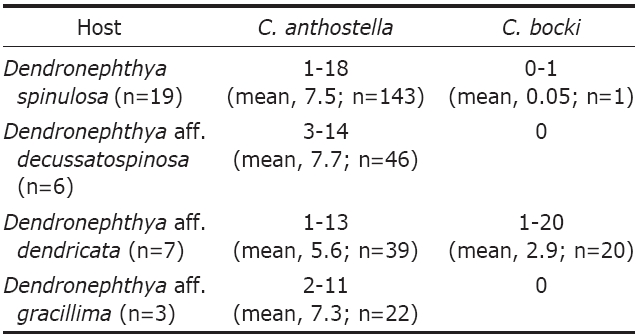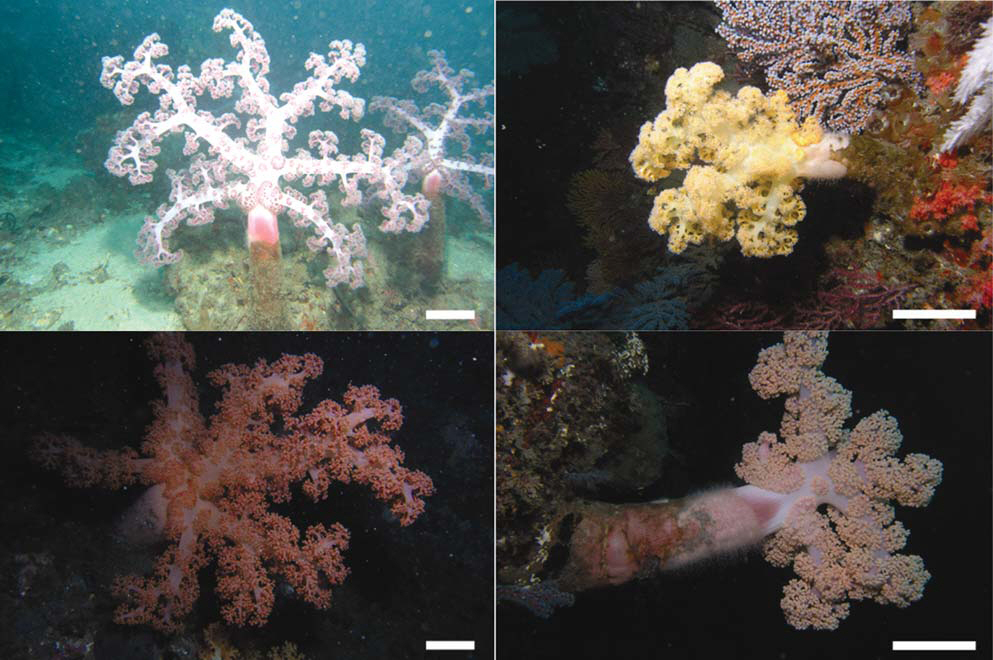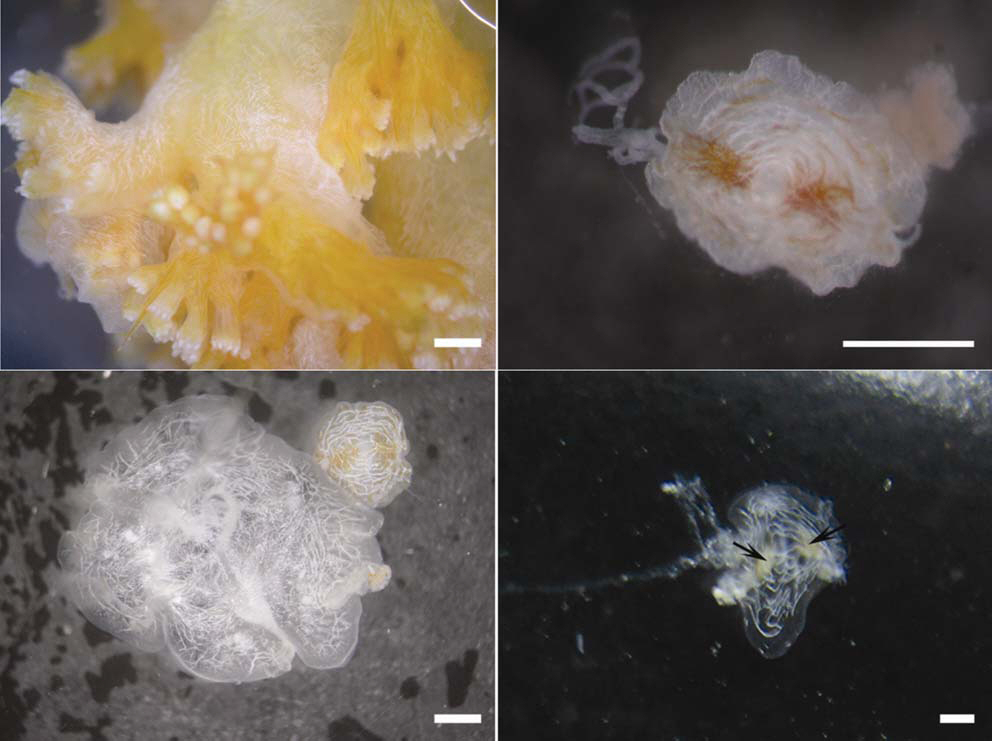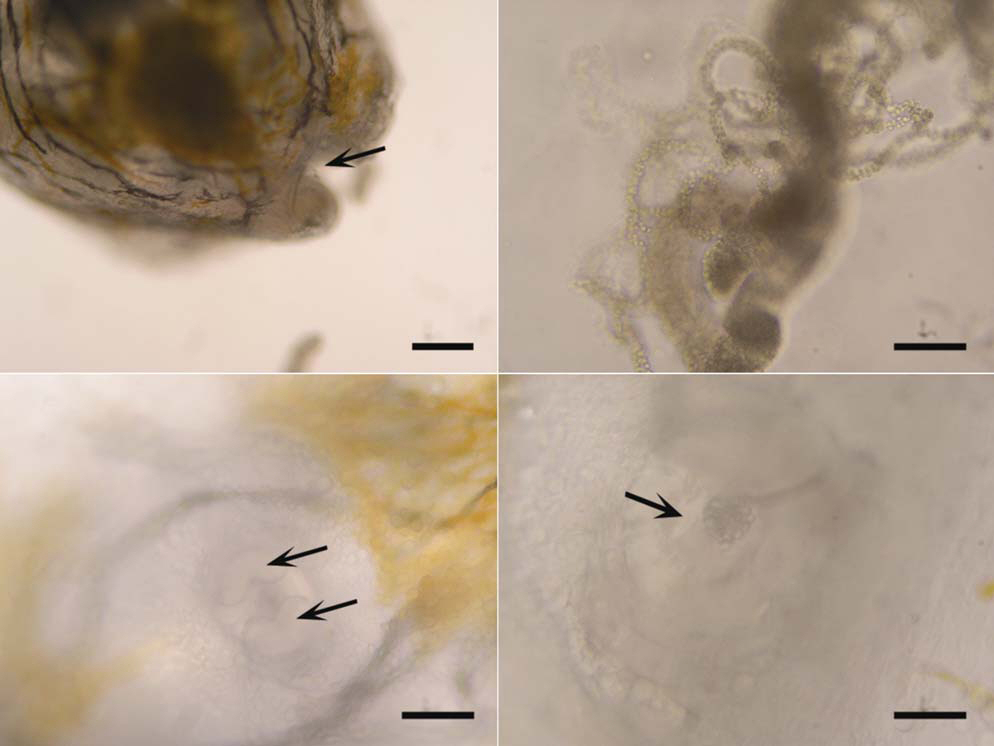



The family Coeloplanidae of comb jellies has a greatly compressed oral-aboral axis, and comprises the genera
Samples were collected by SCUBA from an approximately 20-32 m depth off Munseom Island (33°13′32.45′′N, 126°34′06.84′′E), offshore of Seogwipo-si, Jeju-do, Korea. A single individual of
For species identification, the morphology was examined using a stereomicroscope (Stemi SV-6; Carl Zeiss, Jena, Germany) and optical microscope (Olympus BH2; Olympus, Tokyo, Japan), and measurements were made with an ocular micrometer before anesthetizing the animals with a MgCl2 solution and fixing in 5% neutral formalin.
The morphology of
[Table 1.] PCR primers used in this study

PCR primers used in this study
Bank, Ewha Womans University (Seoul, Korea).
>
Molecular techniques for DNA sequencing
After species identification by microscopy, the samples for molecular analysis were fixed in 100% ethanol before total genomic DNA extraction. The total genomic DNA was extracted using a DNA extraction kit (Qiagen Co., Valencia, CA,USA) according to the manufacturer’s protocol. The target fragments from the three genes (18S, ITS1 and
Phylum Ctenophora Eschscholtz, 1829
Class Tentaculata Eschscholtz, 1825
Subclass Typhlocoela Ospovat, 1985
Order Platyctenida Bourne, 1900
Genus Coeloplana Kowalevsky, 1880
>
Coeloplana anthostella Song and Hwang, 2010 (Fig. 1A-D)
Coeloplana anthostella Song and Hwang, 2010: 217.

Symbiotic relationship between one polyp mass of host dendronephthya species and the number of symbionts Coeloplana spp.
Many inds., Isl. Munseom, 26 Nov 2006, Hwang SJ; many inds., Isl. Munseom, 30 Nov 2006, Hwang SJ; many inds., Isl. Munseom, 2 Dec 2006, Hwang SJ; many inds., Isl. Munseom, 16 Aug 2009, Kim BI, 26-32 m deep by SCUBA; 2 inds., Isl. Munseom, 20 Jun 2010, Hwang SJ, 20-32 m deep by SCUBA.
The GenBank accession numbers: HQ43-5810 (18S rDNA), HQ435812 (ITS1), and HQ435811 (
This species is distinguished from
mm; n=35) had 1-18 aggregated individuals (mean=7.1; n=250) (Table 2).
Korea (Isl. Jejudo).
>
1*Coeloplana bocki Komai, 1920 (Figs. 1A, B, 2, 3)
1 ind., Isl. Munseom, 16 Aug 2009, Kim BI, 26-32 m deep by SCUBA; many inds., Isl. Munseom, 20 Jun 2010, Hwang SJ, 20-32 m deep by SCUBA, attached on polyp mass of
Creeping flattened ctenophore represents somewhat hump-like elevation in its central parts of broad and thin basal expansion (Fig.2 B-D). Oval shape with undulating margin, 2.2×1.9-5.0×4.4 (n=7) mm (tentacular axis×sagittal axis, length×width) at individuals with orange stripes (Fig.2 B), and 3.7×2.6-11.0×5.7 (n=4) mm at ones with milky white stripes (Fig.2 C, D).
Two pinnate tentacles having colloblasts in their surface with one side branches (Figs. 2B, D, 3B) entirely retracted into each tentacle sheath at both ends of tentacular axis. Tip of tentacles globular (0.02×0.02-0.04×0.04 mm in dia.), their side and main branches slender, 0.02-0.05 mm and 0.06-0.09 mm in dia. respectively. Tentacle sheath flask-shaped in aboral view, two tentacle bases separated each other at aboral pole and placed in transverse plane (Fig.2 D). Under stereomicroscope, ramification of gastrovascular system not clearly visible (Fig.2 C, D), but visible under light microscope (Fig.3 A). However, milky white stripes branched and anastomosing not related to each mesh consisting of thin reticulated gastrovascular canals (Fig.3 A).
On aboral pole, polar plate visible, with two lobe-like processes at its peripheral margin, and also raised above its periphery (Fig.3 C). Any other dorsal papillae undeveloped on its dorsal surface. At its center of small individual with
orange stripes, sense organ (0.15×0.15 mm in dia.) with statocyst (0.04×0.04 mm in dia.) in its middle part clearly seen under light microscope (Fig.3 D). Statolith forming one mass of almost 40 granules in its central position of cavity. On oral side, one large mouth (0.6×0.7 mm in dia.) with many pharyngeal folds opened at center of ventral side.
In color, milky white, semi-transparent, with 7-10 blue and 4-6 orange colored branching and anastomosing stripes encircled aboral sense organ towards margin, and reddish orange colored radial stripes at both tentacle bases from one individual on August 16, 2009 (Fig.2 B, D). And also, milky white, semi-transparent, with 7-12 white branching and anastomosing stripes at small individuals and numerous stripes at large ones encircled aboral sense organ towards margin, and also orange colored radial stripes at both tentacle bases from lots of individuals on June 20, 2010 (Fig.2 B-D). However, all of blue and orange colored stripes disappeared in formalin, except for yellowish tentacle bases.
The single individual of this species together with many
The GenBank accession numbers: HQ43-5813 (18S rDNA), HQ435814 (ITS1), and HQ435815 (
The nucleotide sequences of
This species can be distinguished from

Nucleotide sequence differences between Coeloplana anthostella and C. bocki in three gene fragments
Korea (Isl. Jejudo), Japan (Sagami Bay, Tanabe, Misaki).





